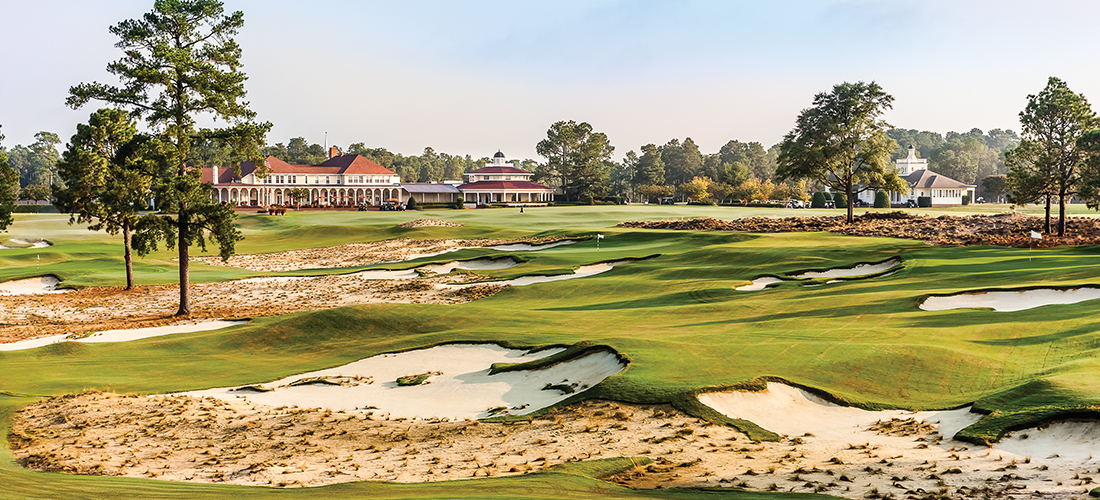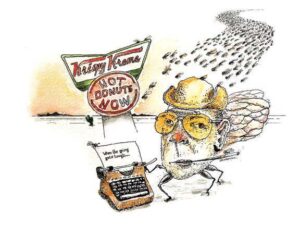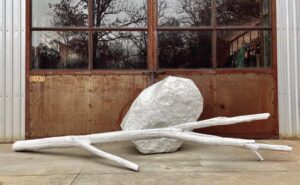
The Cradle, Pinehurst Resort’s latest gift to American golf, is short and oh so sweet
By Lee Pace
An entrepreneur from Boston believed in the late 1800s this barren and arid land in south-central North Carolina ideal to establish a colony for treating consumptives, and soon after he launched full bore into the peach growing industry. But the contagious nature of what became understood as tuberculosis and a pest infestation into the fruit crop stopped both those ideas dead in their tracks.
James Tufts was nothing if not nimble.
The sport of golf was taking root in America, and when Tufts observed some hotel guests flailing away in the dairy fields south of the Village Green with crude implements and rubber balls, he arranged to have nine holes constructed. A fence surrounded the premises, and sheep provided the grass maintenance. But Tufts wasn’t sold on the game’s prospects and inquired of the manager of the Holly Inn, Allen Treadway, if he thought nine more holes would be a good idea.
“Save your money,” answered Treadway. “Golf is a fad and will never last.”
Treadway later went into politics (he served as a Massachusetts Congressional Representative). Enough said there. And Tufts trusted his gut and built more golf. The first 18-hole course at Pinehurst opened in 1899 and ran over ground now occupied by the first and 18th holes of the No. 2 course, the “Maniac Hill” practice range and the area to the south of the existing clubhouse, where until recent times, the first holes of the No. 3 and 5 courses commenced.
“Golf is our third business model — and this one stuck,” says Tom Pashley, president of Pinehurst Inc.
Pinehurst’s quick ascension in the golf world over the first two decades of the 20th century — four courses open by 1919, all available to the traveling public — led to it being called the “St. Andrews of American golf” and the “Cradle of American golf.” Donald Ross, a young greenkeeper and clubmaker who emigrated from Scotland in 1899, developed an aptitude for course design and became quite prolific at it as golfers came from all points in the Northeast and Midwest, enjoyed the experience and enlisted Ross to come to their towns and build 18 holes.
Over time, Ross’s tour de force in the No. 2 course would serve as the venue for seven of golf’s most prestigious competitions — the PGA Championship, Ryder Cup, U.S. Amateur for men and women, U.S. Open for men and women and U.S. Senior Open. Replica trophies for each of those events are housed in a glass case just inside the clubhouse door.
“There’s no other collection of trophies like that in the country,” says Pashley. “Those trophies help give us a sense of place like no other.”
That sense of place has been buffed up in the last half dozen years.
The first domino to fall was the successful conversion in 2010-11 of No. 2 from a burnished and monochromatic green presentation to a rough-hewn and jagged-edge template more in keeping with Ross’s original vision. Then followed a new starter’s hut on the first tee as a replica of the one at St. Andrews and an expansive putting course called Thistle Dhu, also patterned after the Himalayas course at St. Andrews. The resort in the fall of 2016 turned a retail shop overlooking the 18th green into a lively restaurant and veranda bar called “The Deuce” — complete with vintage photos and an appetizer featuring gourmet tater tots and candied bacon.
The latest chapter to Pinehurst’s efforts to be innovative and cutting edge without losing sight of its roots is a nine-hole course called The Cradle, harkening to those early holes from 120 years ago. Pinehurst officials removed the first holes of courses No. 3 and 5 and reconfigured them within the existing routings on the west side of Hwy. 5 and gave that 10-acre parcel to Gil Hanse and partner Jim Wagner. They started work in early June and over the summer sculpted a 789-yard course with holes ranging from 48 to 120 yards long.
The course opened in late September and one of the debut functions held for members and the golf media featured the strains of funk and alternative rock music bellowing out of speakers near the first tee. One golfer played barefoot. Others played with wooden-shafted niblicks, and most carried three or four clubs around in customized Sunday bags — white canvas with leather and tartan trim.
“I have never been to one of our openings where Red Hot Chili Peppers and Cage the Elephant were playing across the sound system,” said Hanse, the 54-year-old architect whose resume includes the 2016 Olympics course in Rio de Janeiro, Brazil and Castle Stuart in the Highlands of Scotland. “Fun has started from the word ‘Go.’ That’s the operative word with The Cradle — fun.”
Hanse’s engagement to design and build the short course sprung from his connection with the resort announced in the fall of 2016 when he was commissioned to redesign course No. 4 at the behest of Pinehurst owner Bob Dedman Jr. and Pashley. They envisioned a companion piece to No. 2 with Bermuda greens and a Sandhills flavor of hardpan, wire grass and raw edges. Dedman had long wanted a par-three course somewhere in the Pinehurst menu, and the idea was hatched to build it and simultaneously redesign the Thistle Dhu course that first opened in 2013, moving it closer to the clubhouse from its footprint a hundred yards away.
“We’d be out on the bulldozers this summer and every time you’d get off and look at this clubhouse and Putter Boy and kind of pinch yourself,” Hanse says. “I mean, really? Are we really getting to work here, in the front yard of Pinehurst?”
The south facade of the clubhouse is vintage Pinehurst, the weathered brick steps and white columns heralding days when the likes of Ben Hogan and Harvie Ward stood there to accept North and South trophies — as pros or amateurs. Today it overlooks The Cradle, with its canted putting greens, meandering bunker shapes and dimensions that run from 56 yards uphill on the sixth to 112 yards downhill to a shallow green on the ninth.
“I love how you see the clubhouse the entire time you’re out here,” says Director of Golf Ben Bridgers. “It’s sort of like Shinnecock in that regard.”
“I think The Cradle will be a great benefit to players’ short games,” adds Pashley. “This course will help them feel how far a 60-yard shot is versus 85 versus 105. Most of us don’t practice those shots often enough and struggle with the feel required to hit shorter distances.”
Hanse applauded the first two aces on The Cradle — one from a 14-year-old, the other from an 84-year-old.
“That encapsulates exactly what we were hoping for,” he says. “We have built a playground where kids and elders can enjoy the game — they can hoot and holler and high-five all they want. It’s a relaxed and comfortable feeling.
“We all remember what brought us into golf in the first place — to hit it hard and laugh and giggle. No one at the beginning sweats over a three-foot putt. Hopefully, we can connect with that innocent, fun part of the game.”
Pinehurst management is noodling all manner of special events built around The Cradle and Thistle Dhu, which has 18 holes laid out and marked with wooden tee markers. The Cradle will cost $50 for an all-day pass, and kids 17 and under play free with a paying adult. The putting course is free. Both are open to the public.
“There are no links in the South to be compared to those at Pinehurst,” noted the local newspaper upon one course opening at Pinehurst, “and they will prove the great magnet of attraction to lovers of the game.”
True in 1898. True as well in 2017. PS
Long-time PineStraw golf columnist Lee Pace recorded the fifth hole-in-one on The Cradle, cozying in a 66-yard sand wedge on the third hole on Oct. 4.





